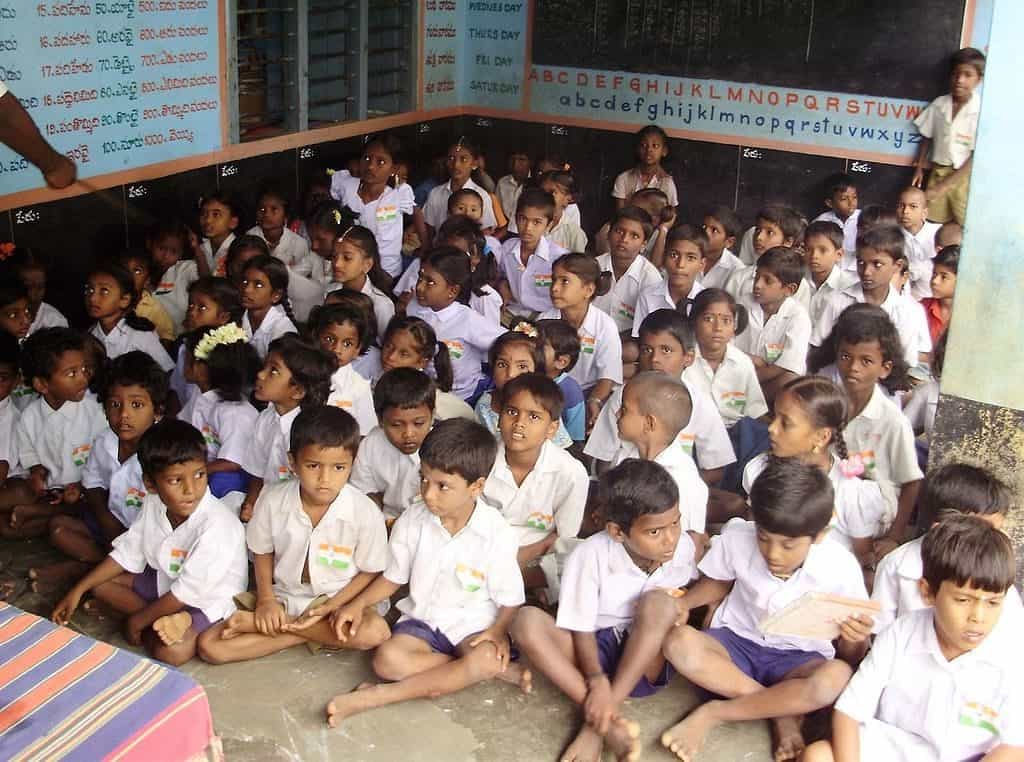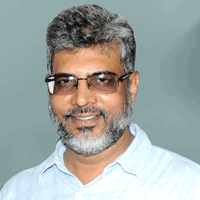
It is a strange question for five-year-old Arya to ask his mother – “How many meetings do I have today?”. But we live in strange times and my friend’s son still cannot wrap his mind around the fact that he is expected to sit in front of a computer from 8.30 am to 12.30 pm for his classes or what he calls “meetings”. His mother, Anitha Anand, a physiotherapist, doesn’t have answers either. And she is not the only one.
As COVID-19 decimates the 2020 academic year, educators are grappling with the necessity to come up with new methods of teaching. At the start of July, a committee constituted by the state government submitted a report giving guidelines for online education, addressing the challenges of educating a demographic that is socially and economically diverse.
In the 40-page document, the committee gives some obvious directives – for example, that schools must ensure that all children have access to learning material – along with some new ideas like sending learning packs to children’s homes. So the question naturally is, did the committee forget to cross the t’s and dot the i’s.
| Some recommendations of the expert committee |
|---|
| * Allow both live and pre-recorded online classes * Parental supervision mandatory for students up to Grade 2 * Screen time and frequency of sessions limited based on age group * Schools to use blended approach, making use of different modes and not just technology * Schools to put their teaching plans and methods in public domain * State Education Department to re-launch its radio and TV broadcasts |
We spoke to Dr Nirajanaradhya V P, a well-known development educationist who was also part of this committee. Nirajanaradhya is Programme Head – Universalization of Equitable Quality Education Programme at the NLSIU (National Law School of India University), and a also member of the Karnataka State Commission for Protection of Child Rights.

We discussed a number of issues addressed in the report as well as outside of it: Was this is an opportunity to re-imagine our education system, or have we missed the boat? What is the way forward?
Excerpts:
Q: What have been the government’s major challenges in dealing with the new situation, and what was the thought process behind the committee?
A: The biggest challenge for the government has been the handling of private schools. When the committee was looking at drafting the guidelines, schools affiliated to different boards took part in the discussions. But there were a lot of confusions and confrontations amidst themselves, especially among schools affiliated to ICSE and CBSE syllabi. Then there was the problem with low-budget private schools. Clearly, the government cannot come up with one single solution for this problem of changing the teaching methods.
Another major concern was, how do we reach every child given the segregation they face, and create a level playing field. Government has the problem of figuring out how to reach students in its own schools. There are about 80,000 government schools in the state, with about one million children in them. Of course, the government is confident about reaching these children because it has access to radio and TV programmes from earlier. As a committee, we helped the government address the issue in a holistic manner and not just in terms of the online medium. We need to integrate digital and non-digital methods wherever possible. We need to customise the solution depending on the groups, and I hope we can do that. We need to consider limiting the screen time for children considering their mental health.
Q: According to a recent white paper, about 37 million schoolchildren in India have their studies disrupted every year because of natural calamities. Have we learnt no lessons from their strife, and is this a case of reinventing the wheel?
A: We didn’t discuss this as a committee, but in an individual capacity I had a couple of student researchers look at this – the Gujarat earthquake, SARS, etc., and what was done then to continue teaching. We found that TV and radio were used in a big way to reach out to the children. But what we are discussing today isn’t about just completing the syllabus. It is about engaging with children through activities, and them continuing learning in that sense.
This is about ensuring that children don’t slip into depression, anxiety because there is nothing constructive to engage their minds. We came up with the idea of having learning packs for the children we cannot reach through even radio – to deliver these once in 2-3 days, so the teacher has face-to-face interaction with the child and family.
Q: But when you speak of learning packs, what happens to children from marginalised families whose parents won’t be able to help them with the academic load?
A: With education being a basic right, the responsibility automatically falls on the State to ensure that these children do not miss out. The solution we thought of is to make use of teachers in a big way because they are the only human resource available to the Education Department. But apart from them, the larger reach is that of radio and TV – not only to engage with younger children but to also ensure that older children don’t miss out on the core components of education.
Q: How do you expect government teachers to cope with these additional requirements, given they already struggle with the demands made of them?
A: Well, we have also suggested that the local CBOs (Community Based Organisations) and young people be used for teaching. Obviously, we can’t entrust it only to the teachers. This is an unprecedented crisis and so our responses need to be unprecedented as well. So it isn’t burdening the teachers, but bringing the community together.
Q: Still, teachers need to revamp their skill sets to deal with the new demands made of them.
A: The focus is on helping teachers use technology. The DSCERT (Department of State Educational Research and Training) has begun to create small videos to help teachers to this end, because it is the academic authority and has been given the authority to implement this. When parts of the state were under lockdown and teachers comparatively free, this time was used to train them. DSCERT will probably come up with a module soon.
Q: There are also children who became part of private schools through RTE. How do you suggest they get access to the course material, given the cost of the infrastructure required at home?
A: When I looked at the numbers of children coming from impoverished and backward caste families, there are almost equal number of them in government schools and in [low-budget] private schools. So the perception that all private school students are from the upper middle class is wrong. So this idea of access to computers, mobiles… and even with mobiles, we made it very clear that it is not the best thing to use given the screen size, band width, etc.
So our solution needs to be a mix of digital, non digital and face-to-face. So it is not that we suggest online for private schools and offline for government schools. It needs to be a combination. And the schools also have to come up with plans. Of course, there was a suggestion that the rich parents can help out poorer children, which I don’t think will work. It is the primary obligation of the state, and should not be palmed off to the charity of others.
Q: The cost of this revamp – whether it is government schools or private schools – the committee has not proposed the idea of fee slabs to ease the burden on the parents. Was this an oversight or deliberately left out?
A: It is not that committee has not touched upon it, but it was not the mandate given to us. Our mandate was to understand the ways and means for online education. Yes, there is a cost factor to it. That is why we brought in the idea of a redressal mechanism for parents to complain against inflated fees. But schools too have an obligation to find a solution without exploiting parents. These issues need to be addressed at the school-level and they have to be given some autonomy for that. We can’t address that as a committee.
Q: Giving autonomy is one thing, but stating the obvious is another. For example, “new methods of assessment should be put in place”. We know that, but the committee does not go into how to do that. Shouldn’t there be more detail?
A: We did discuss all of this at that start. But our job isn’t to get into the micro management of issues, like I said. Our mandate was to evolve a macro plan. The DSCERT, as the academic authority, needs to figure all of this out when they issue guidelines.
Our main concern was, what are the implications for the children using technology for a longer duration. We had been talking about integrating technology for a while now, even before COVID happened. So now would be a good time to figure how much and to what extent it should be included.
Q: What do you see as the long-term impacts of this forced gap on the core learning competencies of children?
A: Let us first understand that these problems with learning have not happened during COVID alone. They have existed before as well. This problem needs to be located in the larger context of what the purpose of education is.
Q: While the private school kids have online classes, the government school kids have no idea what to do. How much of an impact has it had?
A: Every government school has at least two rooms and the strength isn’t much. We can still open these facilities and practice social distancing along with other safety measures. Because even the MHRD minister predicted that 30% of the children may not return to school at all, because the skill sets they develop while working will come more handy and seem more practical to their families who are struggling with the financial repercussions of the pandemic. That is why we are suggesting that the teachers continue to keep connecting with the children and their families. Because there will be repercussions in terms of child marriage, school dropouts, malnutrition, domestic abuse, etc.
And in villages, the school isn’t just about literacy. It is about midday meals for the kids. We [Karnataka] did have the Kerala model where we ensured that rations were reaching the families till April. But we should also look at Orissa and how it has been ensuring that children get their meal. Because immunity is the crux of battling this pandemic.
Q: This crisis has given us an unintended opportunity to reimagine the education system. What do you think are the lessons we need to take from it?
A: For one, we need to invest more in it. For example, currently the Centre spends less than 0.45% of the GDP on education. That needs to change. We need to invest in our teachers. We need to invest in our classrooms. Because what this pandemic has taught us is what our list of priorities should be.